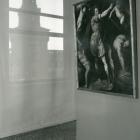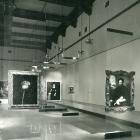Upon the inauguration of the Museo Archeologico e Artistico in 1900 the Gallery's entire collection occupied what is now room XXVI, where it was brought together under the supervision of Carlo Ermes Visconti, assisted by Giovanni Battista Vittadini. The permanent exhibition was expanded almost immediately into the adjacent rooms, where frescoes and paintings were displayed next to furniture and furnishings. A profound change of course came about in 1935 following the acquisition of the extraordinary collection of Prince Luigi Alberico Trivulzio: the monumental room XXVI was chosen to house the hangings, codices, the archaeological and artistic exhibits, displayed in sumptuous cabinets, still conserved among the relics of the historic mountings.
The Gallery in the second half of the 20th century
Once the property that could be removed was returned to the museum from the places of safekeeping at the end of the Second World War, a complex, general phase of reorganisation and study began, which involved various sections. Two adjacent rooms (XX and XXVI) on the first floor of the Ducal Court were chosen to house the Art Gallery, a choice which came to have a precise physiognomy in two particular moments (1956; 1980). Costantino Baroni was responsible for the museological criteria, while the architectural firm, BBPR, assisted by the Technical Departments of the Municipality of Milan handled the museographical decisions. One of the decisions, aimed at making a further expansion of the collection possible and which is still visible today, was that of transferring the large sections of frescoes in other areas of the castle, namely on the ground floor of the Ducal Court and in the Rocchetta. In 1980 an experimental phase of a new arrangement was launched in rooms XX and XXV, promoted by director Mercedes Precerutti Garberi and the Albini-Helg Piva architectural firm.
A new permanent exhibition
The current arrangement of the collection dates to 2005 and was curated by Mauro Natale and Laura Basso with interventions by the architect Valter Palmieri. One of the original characteristics is the dual itinerary that winds its way between the seven historical rooms: the itinerary of the foundational moments of Lombard painting and the parallel itinerary which centres on the salient points of castle architecture in the modern urban landscape of Milan. Focused photographic campaigns document the environment during the mounting phases, as well as details of exhibition systems, starting from the first arrangement of 1900; among these works are also the photographs of Mario Perotti (1953-1956), Paolo Monti (1956) and those of Aldo Ballo (1980) (Archivio Civiche Raccolte d’Arte; Civico Archivio Fotografico).









